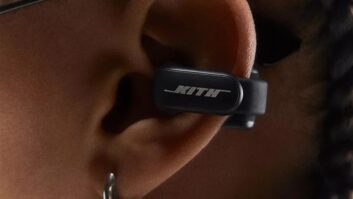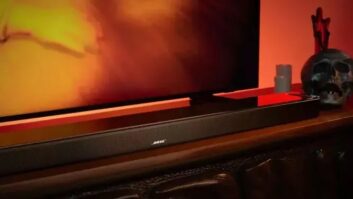Bose’s latest table radio/CD performs well enough to be “the principal stereo source for many homes” despite its compact size and use of only two 2.5-inch drivers, company chairman Amar Bose contends.
The new $499 table radio/CD, called the Bose Wave music system, will appeal to music enthusiasts who don’t want to fuss with multiple-component hookups, he said.
Dr. Bose attributes a “huge jump” in performance over the current $499 Wave radio/CD to longer throw drivers, a new waveguide design and Bose’s first-ever implementation of digital-domain audio signal processing in a table radio.
DSP technology has evolved to the point that Bose is able to use “psychoacoustic techniques that we couldn’t use before,” Dr. Bose said. Bose’s implementation uses 160,000 lines of code.
The trio of design changes yields lower bass, enhanced clarity and definition, and an exceptionally wide sound stage, the company said. The product has generated more excitement in the company than any other product introduction, Dr. Bose added.
The new table radio/CD is the same size and price as the current Wave radio/CD and will be available in September through Bose-operated stores, Bose’s direct-marketing operation and select catalogs, said home entertainment VP Bob Maresca.
Other enhancements include MP3-CD playback, display of MP3 metadata, improved tuner selectivity, greater amplifier power and a talk-radio mode to compensate for the boominess of male voices on AM stations that boost low-frequency response to compensate for anemic bass response in lower quality AM radios .
It’s also the industry’s first table radio that can be networked. Via wired Bose Link technology, it plays back music from new Lifestyle home theater systems equipped with hard disk-drive music storage and located in a remote room.
Also new: a capacitor to preserve alarm clock functions and other system settings for up to 48 hours if power is lost. The current model uses a 9-volt battery.
The new model also eliminates on-chassis controls, moving all controls to a pair of easier-to-use IR remotes.
Inside, the use of digital technology enabled Bose to shrink the amount of room needed for circuit boards, opening up enough internal-chassis space to incorporate a 26-inch wave guide for each driver. In the current CD radio, only one of the 2.5 –inch drivers is fitted with a bass-enhancing wave guide.
With dual-wave guides and the new drivers, the new system reproduces notes that are a half-octave lower than what the predecessor system yielded, the company said without elaborating. Bose also didn’t disclose the power output of the system’s analog amps.
The system doesn’t use digital amplifiers because they would generate AM-band interference, Dr. Bose said.
Although he agreed the table radio’s performance could potentially affect sales of the company’s briefcase-size, higher power, one-piece Acoustic Wave music systems at $1,079 and $1,378, Dr. Bose said companies “should never be afraid of outdating products with their own products.” The Acoustic Wave systems don’t incorporate audio DSP.
The company isn’t engaged in talks with video companies to license the technology for use in TVs, Dr. Bose said, because the company wants to “control all phases” of design and production to ensure audio performance.
The company didn’t disclose its annual table radio sales, but one competitor said it’s probably about a million units per year combined for Bose’s $349 non-CD model and the current $499 CD-equipped model.
During an A/B comparison conducted here at moderate output levels for the press, the Wave music system compared favorably with a pair of its top-tier 901 active speakers fed by a common music source.













